International Marketing Analysis of Adidas: A Comprehensive Report
VerifiedAdded on 2023/04/24
|20
|4226
|163
Report
AI Summary
This report provides a comprehensive analysis of Adidas's marketing strategies, competitive positioning, and challenges in the global market. It begins with an executive summary outlining the report's objectives, which are to evaluate Adidas's current business policies, competitive strategies, and STP approaches. The report delves into Adidas's product differentiation, market focus, and brand communication strategies, comparing them to those of Nike. It examines Adidas's segmentation, targeting, and positioning strategies, as well as the issues related to online sales. The report identifies external factors, including political and economic influences, using a PEST analysis. Based on these findings, the report recommends growth strategies such as product development, extensive distribution, and market entry strategies to enhance Adidas's international business performance. The report concludes with a summary of key findings and recommendations, supported by academic references.
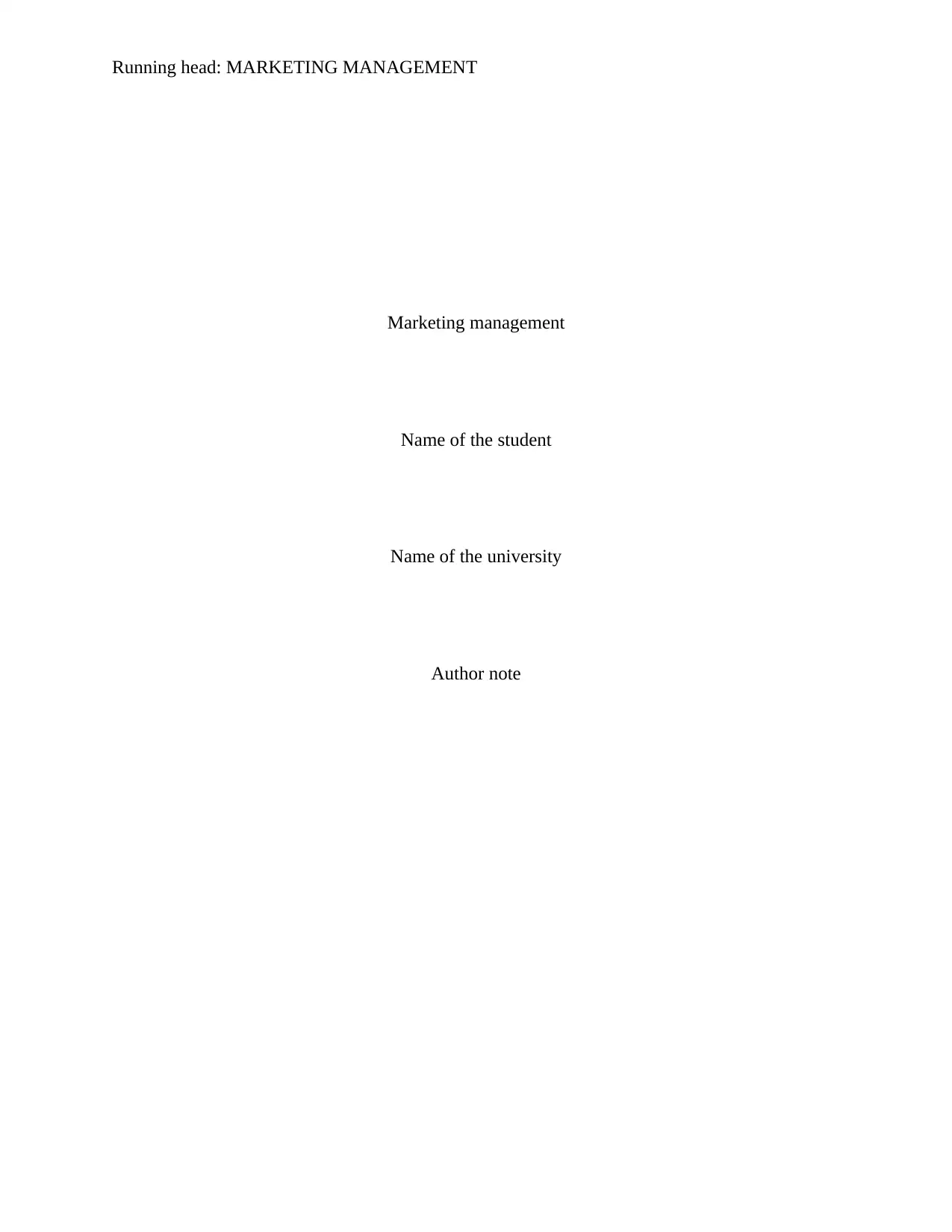
Running head: MARKETING MANAGEMENT
Marketing management
Name of the student
Name of the university
Author note
Marketing management
Name of the student
Name of the university
Author note
Paraphrase This Document
Need a fresh take? Get an instant paraphrase of this document with our AI Paraphraser
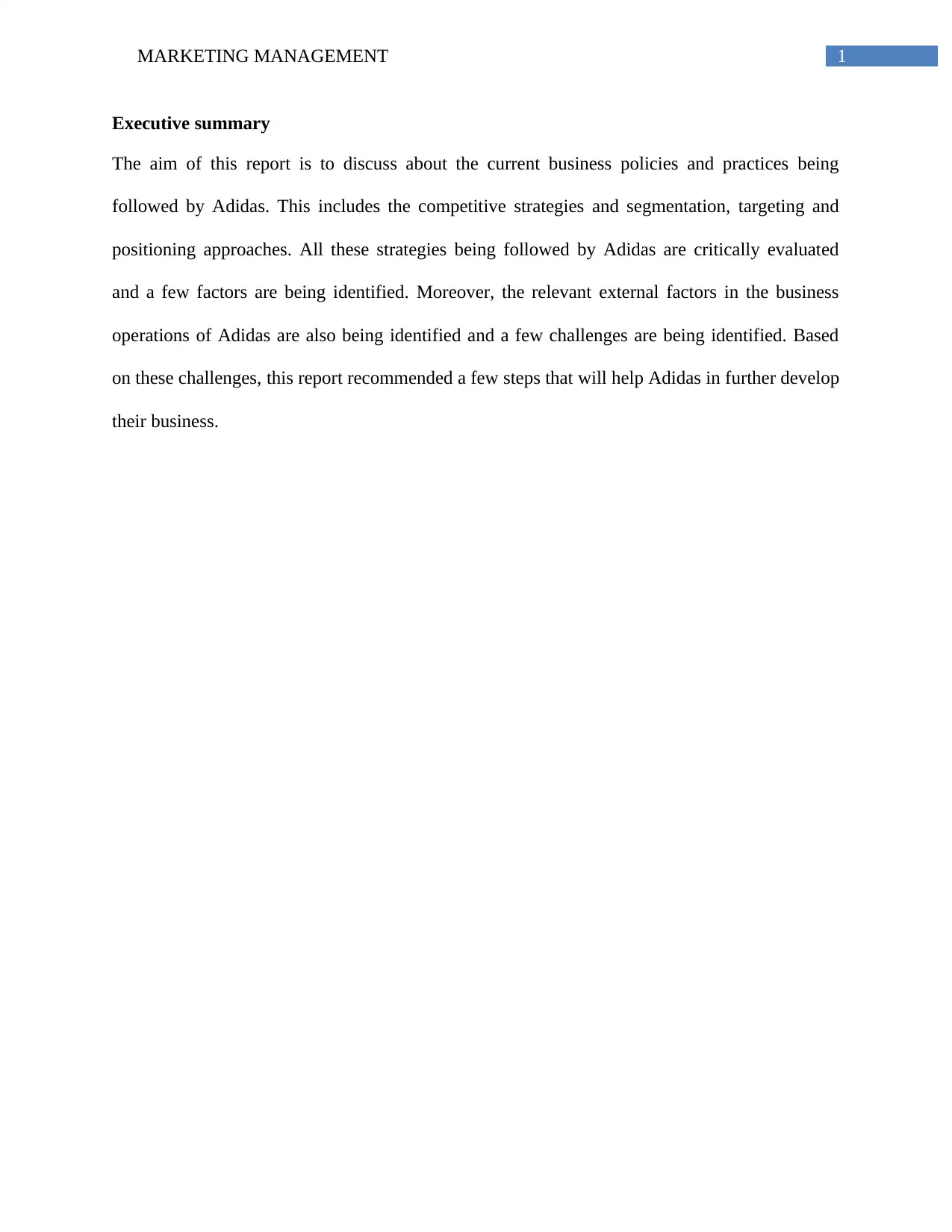
1MARKETING MANAGEMENT
Executive summary
The aim of this report is to discuss about the current business policies and practices being
followed by Adidas. This includes the competitive strategies and segmentation, targeting and
positioning approaches. All these strategies being followed by Adidas are critically evaluated
and a few factors are being identified. Moreover, the relevant external factors in the business
operations of Adidas are also being identified and a few challenges are being identified. Based
on these challenges, this report recommended a few steps that will help Adidas in further develop
their business.
Executive summary
The aim of this report is to discuss about the current business policies and practices being
followed by Adidas. This includes the competitive strategies and segmentation, targeting and
positioning approaches. All these strategies being followed by Adidas are critically evaluated
and a few factors are being identified. Moreover, the relevant external factors in the business
operations of Adidas are also being identified and a few challenges are being identified. Based
on these challenges, this report recommended a few steps that will help Adidas in further develop
their business.
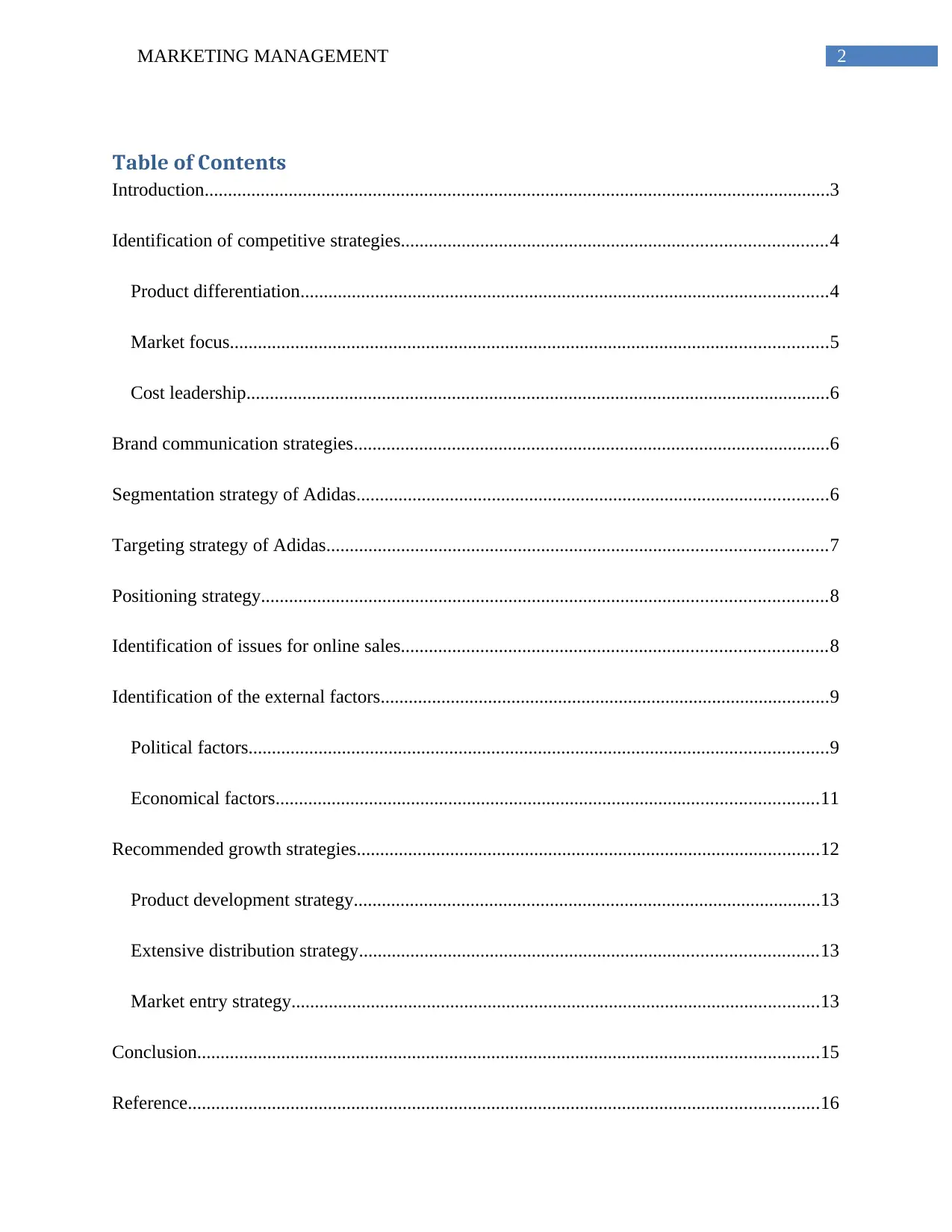
2MARKETING MANAGEMENT
Table of Contents
Introduction......................................................................................................................................3
Identification of competitive strategies...........................................................................................4
Product differentiation.................................................................................................................4
Market focus................................................................................................................................5
Cost leadership.............................................................................................................................6
Brand communication strategies......................................................................................................6
Segmentation strategy of Adidas.....................................................................................................6
Targeting strategy of Adidas...........................................................................................................7
Positioning strategy.........................................................................................................................8
Identification of issues for online sales...........................................................................................8
Identification of the external factors................................................................................................9
Political factors............................................................................................................................9
Economical factors....................................................................................................................11
Recommended growth strategies...................................................................................................12
Product development strategy....................................................................................................13
Extensive distribution strategy..................................................................................................13
Market entry strategy.................................................................................................................13
Conclusion.....................................................................................................................................15
Reference.......................................................................................................................................16
Table of Contents
Introduction......................................................................................................................................3
Identification of competitive strategies...........................................................................................4
Product differentiation.................................................................................................................4
Market focus................................................................................................................................5
Cost leadership.............................................................................................................................6
Brand communication strategies......................................................................................................6
Segmentation strategy of Adidas.....................................................................................................6
Targeting strategy of Adidas...........................................................................................................7
Positioning strategy.........................................................................................................................8
Identification of issues for online sales...........................................................................................8
Identification of the external factors................................................................................................9
Political factors............................................................................................................................9
Economical factors....................................................................................................................11
Recommended growth strategies...................................................................................................12
Product development strategy....................................................................................................13
Extensive distribution strategy..................................................................................................13
Market entry strategy.................................................................................................................13
Conclusion.....................................................................................................................................15
Reference.......................................................................................................................................16
⊘ This is a preview!⊘
Do you want full access?
Subscribe today to unlock all pages.

Trusted by 1+ million students worldwide

3MARKETING MANAGEMENT
Paraphrase This Document
Need a fresh take? Get an instant paraphrase of this document with our AI Paraphraser

4MARKETING MANAGEMENT
Introduction
The current business scenario is much more challenging and complex for the
contemporary business organizations due to the high intensity of competition. Thus, it is
important for the contemporary business organizations to have innovative and extensive business
and marketing strategies in staying ahead in the competition. These strategies include growth
strategy, mitigation strategies and competitive strategies. The complexities in doing business are
more for the multinational organizations due to the reason that they are facing the different and
diverse business scenario in different regions across the world. They are having the need for
effective and integrated marketing and business approach that can be beneficial in managing
different factors in the business. Moreover, these approaches should be in the line of current
market and business situations to have the maximum desired outcome in the long term.
Adidas is one of the leading and well known names in the current business scenario with
having their operations in different countries across the world. They are also competing with
some leading brands such as Reebok and Nike in the same market segment. However, on the
other hand, there are number of challenges being faced by them mainly in terms of political
issues. It is important for Adidas to mitigate these challenges and initiate the growth strategies in
the long term. This report will discuss about the competitive strategies being followed by them
and their competitive strategies will be compared with that of Nike. In addition, this report will
also discuss about the segmentation targeting and positioning being followed by Adidas.
Different growth and challenges being faced by them in their international business will also be
identified with the help of PEST analysis. Based on these factors, a few recommended steps will
be discussed in terms of growth strategies. The existing entry strategies of Adidas will be
Introduction
The current business scenario is much more challenging and complex for the
contemporary business organizations due to the high intensity of competition. Thus, it is
important for the contemporary business organizations to have innovative and extensive business
and marketing strategies in staying ahead in the competition. These strategies include growth
strategy, mitigation strategies and competitive strategies. The complexities in doing business are
more for the multinational organizations due to the reason that they are facing the different and
diverse business scenario in different regions across the world. They are having the need for
effective and integrated marketing and business approach that can be beneficial in managing
different factors in the business. Moreover, these approaches should be in the line of current
market and business situations to have the maximum desired outcome in the long term.
Adidas is one of the leading and well known names in the current business scenario with
having their operations in different countries across the world. They are also competing with
some leading brands such as Reebok and Nike in the same market segment. However, on the
other hand, there are number of challenges being faced by them mainly in terms of political
issues. It is important for Adidas to mitigate these challenges and initiate the growth strategies in
the long term. This report will discuss about the competitive strategies being followed by them
and their competitive strategies will be compared with that of Nike. In addition, this report will
also discuss about the segmentation targeting and positioning being followed by Adidas.
Different growth and challenges being faced by them in their international business will also be
identified with the help of PEST analysis. Based on these factors, a few recommended steps will
be discussed in terms of growth strategies. The existing entry strategies of Adidas will be

5MARKETING MANAGEMENT
evaluated and new strategies will be recommended, which will further help them to enhance their
international business.
Identification of competitive strategies
Product differentiation
In terms of the competitive strategies, both Nike and Adidas are following similar
approaches due to the reason that both of these brands are operating in the same market segment
and offering same sets of products. According to the Porter’s generic model of competitive
strategies, it is identified that both Nike and Adidas are following product differentiation and
market focus strategy rather than the cost leadership strategy. This is due to the reason that both
Adidas and Nike are offering premium products with higher end pricing. In terms of Adidas, it is
identified that product differentiation is the key for their competitiveness. As per Mahdi et al.
(2015), currently Adidas is offering sports apparel including shoes, wearable and accessories.
These products are also being offered by other leading brands such as Nike, Puma and Reebok.
With the help of the product differentiation strategy, Adidas is being able to create distinctive
positioning in the market. According to the authors, the Adidas logo printed in the sides of the
shoes and frontal part of the t-shirts is one of the key distinguishing factors. Differentiation is
being followed in terms of design also. This is due to the fact that design of the Adidas is
exclusive to them and same designs are not being followed by others.
evaluated and new strategies will be recommended, which will further help them to enhance their
international business.
Identification of competitive strategies
Product differentiation
In terms of the competitive strategies, both Nike and Adidas are following similar
approaches due to the reason that both of these brands are operating in the same market segment
and offering same sets of products. According to the Porter’s generic model of competitive
strategies, it is identified that both Nike and Adidas are following product differentiation and
market focus strategy rather than the cost leadership strategy. This is due to the reason that both
Adidas and Nike are offering premium products with higher end pricing. In terms of Adidas, it is
identified that product differentiation is the key for their competitiveness. As per Mahdi et al.
(2015), currently Adidas is offering sports apparel including shoes, wearable and accessories.
These products are also being offered by other leading brands such as Nike, Puma and Reebok.
With the help of the product differentiation strategy, Adidas is being able to create distinctive
positioning in the market. According to the authors, the Adidas logo printed in the sides of the
shoes and frontal part of the t-shirts is one of the key distinguishing factors. Differentiation is
being followed in terms of design also. This is due to the fact that design of the Adidas is
exclusive to them and same designs are not being followed by others.
⊘ This is a preview!⊘
Do you want full access?
Subscribe today to unlock all pages.

Trusted by 1+ million students worldwide
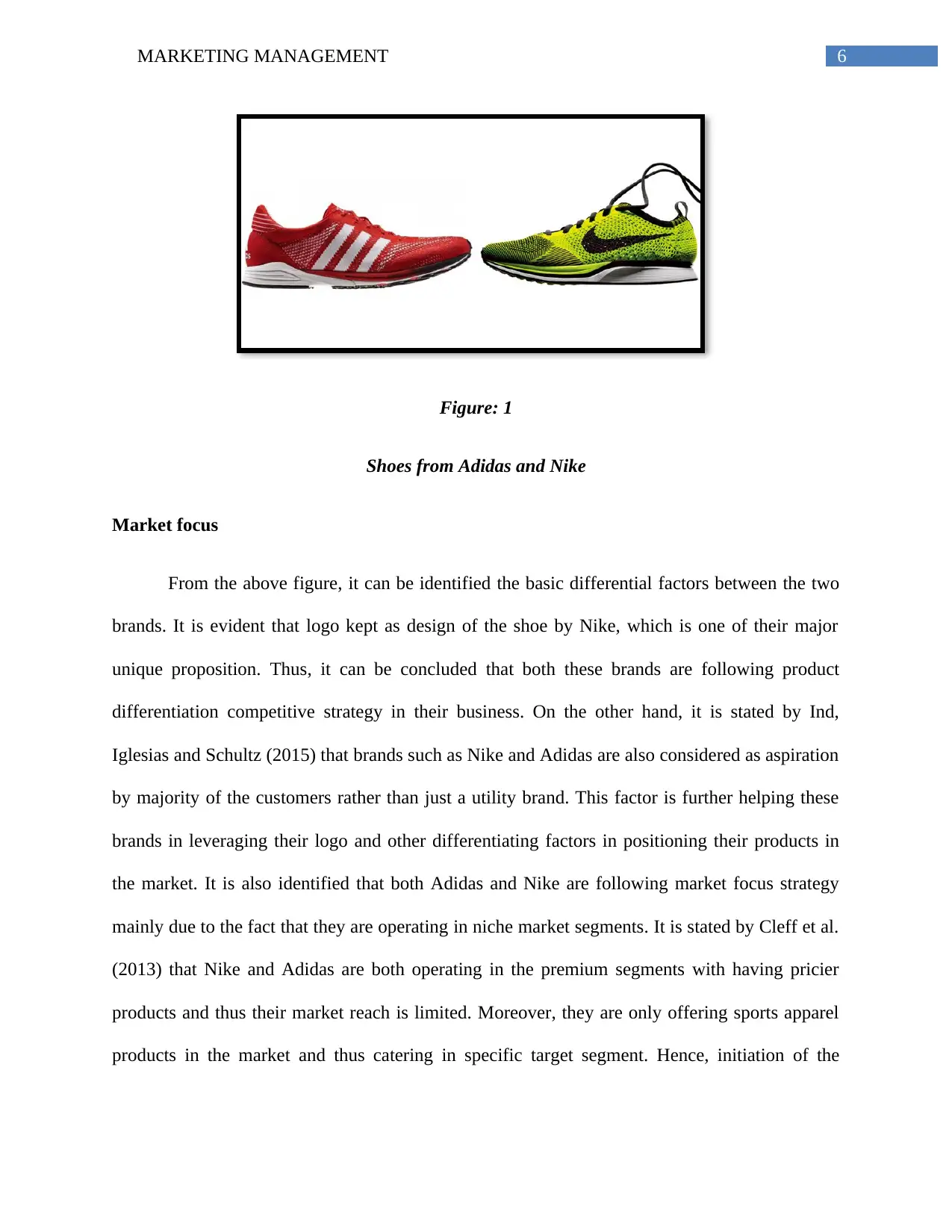
6MARKETING MANAGEMENT
Figure: 1
Shoes from Adidas and Nike
Market focus
From the above figure, it can be identified the basic differential factors between the two
brands. It is evident that logo kept as design of the shoe by Nike, which is one of their major
unique proposition. Thus, it can be concluded that both these brands are following product
differentiation competitive strategy in their business. On the other hand, it is stated by Ind,
Iglesias and Schultz (2015) that brands such as Nike and Adidas are also considered as aspiration
by majority of the customers rather than just a utility brand. This factor is further helping these
brands in leveraging their logo and other differentiating factors in positioning their products in
the market. It is also identified that both Adidas and Nike are following market focus strategy
mainly due to the fact that they are operating in niche market segments. It is stated by Cleff et al.
(2013) that Nike and Adidas are both operating in the premium segments with having pricier
products and thus their market reach is limited. Moreover, they are only offering sports apparel
products in the market and thus catering in specific target segment. Hence, initiation of the
Figure: 1
Shoes from Adidas and Nike
Market focus
From the above figure, it can be identified the basic differential factors between the two
brands. It is evident that logo kept as design of the shoe by Nike, which is one of their major
unique proposition. Thus, it can be concluded that both these brands are following product
differentiation competitive strategy in their business. On the other hand, it is stated by Ind,
Iglesias and Schultz (2015) that brands such as Nike and Adidas are also considered as aspiration
by majority of the customers rather than just a utility brand. This factor is further helping these
brands in leveraging their logo and other differentiating factors in positioning their products in
the market. It is also identified that both Adidas and Nike are following market focus strategy
mainly due to the fact that they are operating in niche market segments. It is stated by Cleff et al.
(2013) that Nike and Adidas are both operating in the premium segments with having pricier
products and thus their market reach is limited. Moreover, they are only offering sports apparel
products in the market and thus catering in specific target segment. Hence, initiation of the
Paraphrase This Document
Need a fresh take? Get an instant paraphrase of this document with our AI Paraphraser
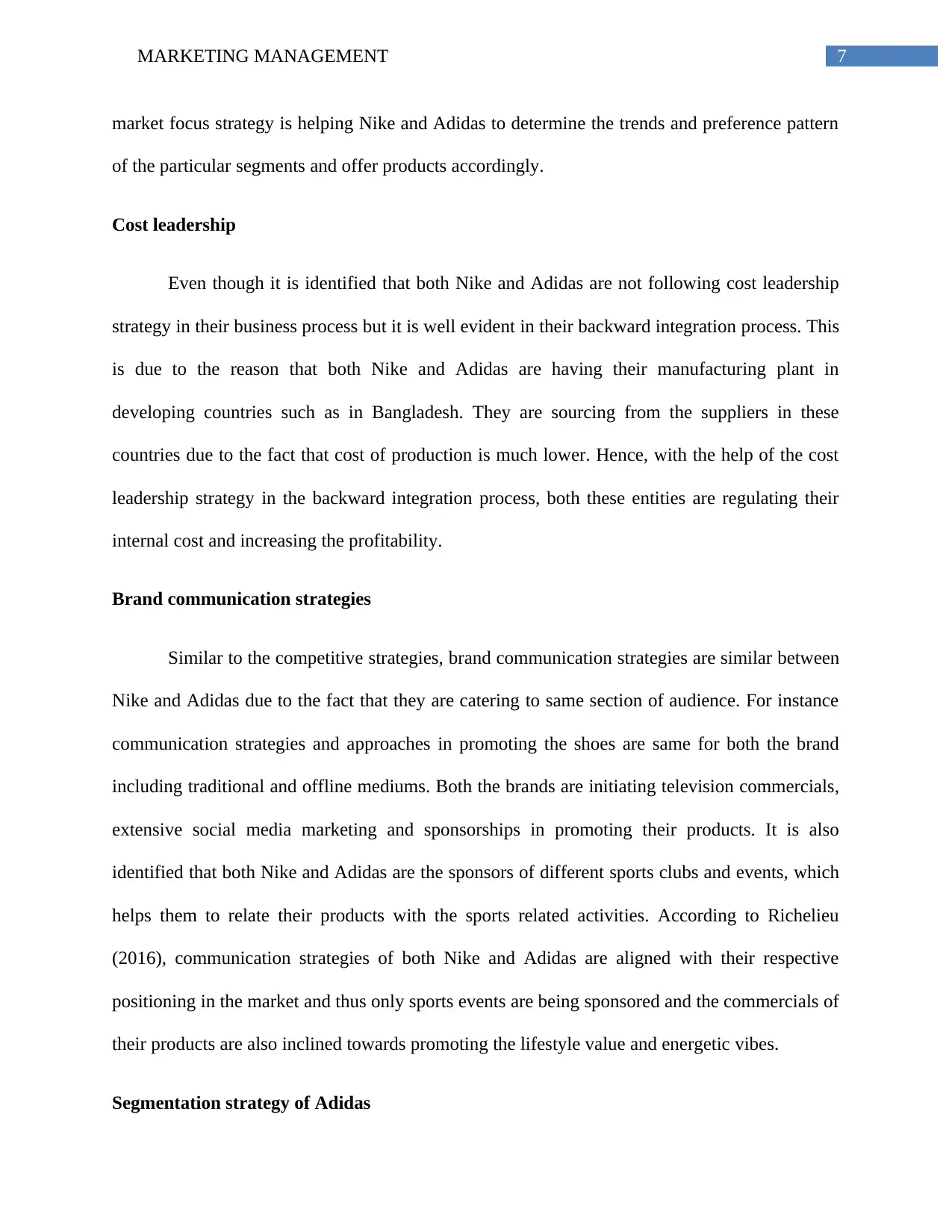
7MARKETING MANAGEMENT
market focus strategy is helping Nike and Adidas to determine the trends and preference pattern
of the particular segments and offer products accordingly.
Cost leadership
Even though it is identified that both Nike and Adidas are not following cost leadership
strategy in their business process but it is well evident in their backward integration process. This
is due to the reason that both Nike and Adidas are having their manufacturing plant in
developing countries such as in Bangladesh. They are sourcing from the suppliers in these
countries due to the fact that cost of production is much lower. Hence, with the help of the cost
leadership strategy in the backward integration process, both these entities are regulating their
internal cost and increasing the profitability.
Brand communication strategies
Similar to the competitive strategies, brand communication strategies are similar between
Nike and Adidas due to the fact that they are catering to same section of audience. For instance
communication strategies and approaches in promoting the shoes are same for both the brand
including traditional and offline mediums. Both the brands are initiating television commercials,
extensive social media marketing and sponsorships in promoting their products. It is also
identified that both Nike and Adidas are the sponsors of different sports clubs and events, which
helps them to relate their products with the sports related activities. According to Richelieu
(2016), communication strategies of both Nike and Adidas are aligned with their respective
positioning in the market and thus only sports events are being sponsored and the commercials of
their products are also inclined towards promoting the lifestyle value and energetic vibes.
Segmentation strategy of Adidas
market focus strategy is helping Nike and Adidas to determine the trends and preference pattern
of the particular segments and offer products accordingly.
Cost leadership
Even though it is identified that both Nike and Adidas are not following cost leadership
strategy in their business process but it is well evident in their backward integration process. This
is due to the reason that both Nike and Adidas are having their manufacturing plant in
developing countries such as in Bangladesh. They are sourcing from the suppliers in these
countries due to the fact that cost of production is much lower. Hence, with the help of the cost
leadership strategy in the backward integration process, both these entities are regulating their
internal cost and increasing the profitability.
Brand communication strategies
Similar to the competitive strategies, brand communication strategies are similar between
Nike and Adidas due to the fact that they are catering to same section of audience. For instance
communication strategies and approaches in promoting the shoes are same for both the brand
including traditional and offline mediums. Both the brands are initiating television commercials,
extensive social media marketing and sponsorships in promoting their products. It is also
identified that both Nike and Adidas are the sponsors of different sports clubs and events, which
helps them to relate their products with the sports related activities. According to Richelieu
(2016), communication strategies of both Nike and Adidas are aligned with their respective
positioning in the market and thus only sports events are being sponsored and the commercials of
their products are also inclined towards promoting the lifestyle value and energetic vibes.
Segmentation strategy of Adidas
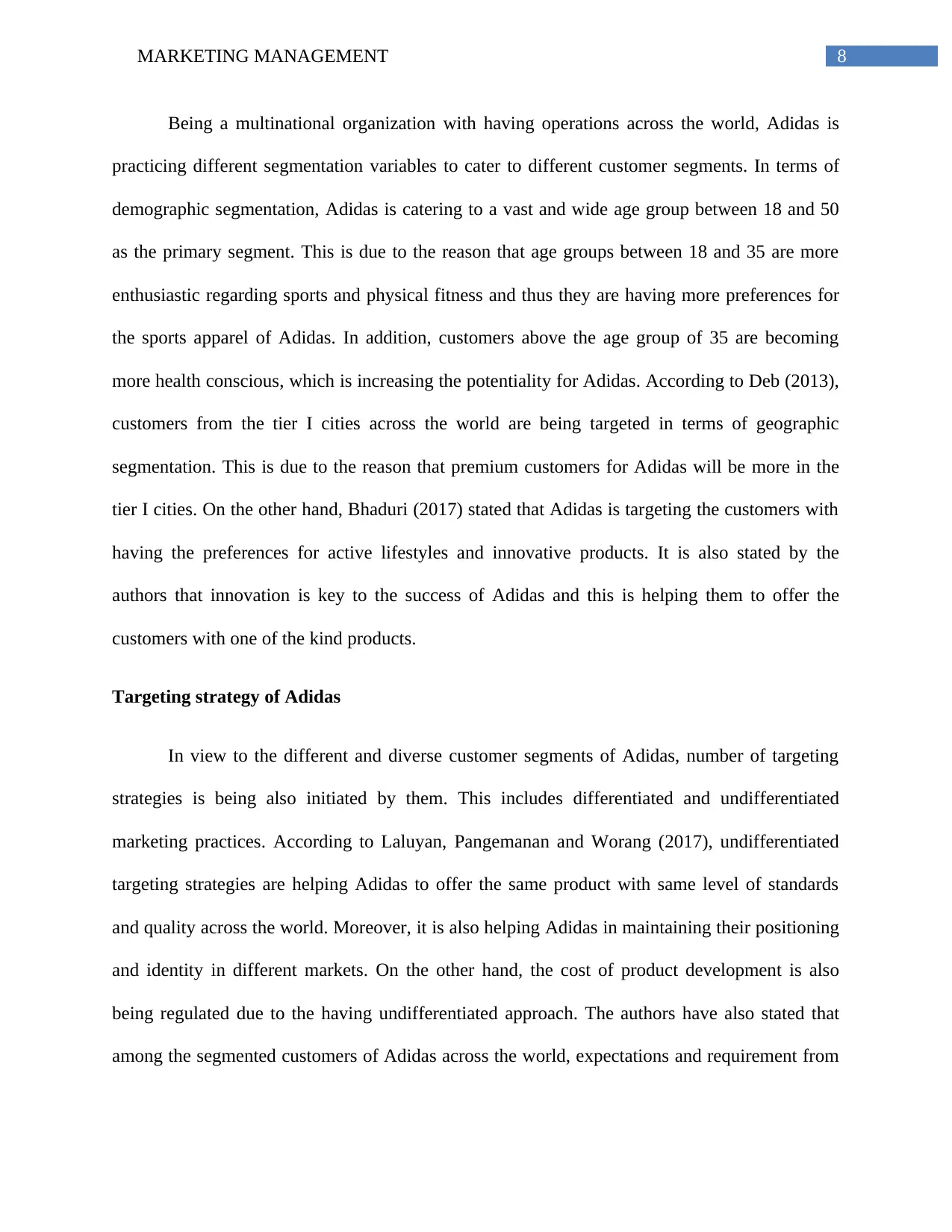
8MARKETING MANAGEMENT
Being a multinational organization with having operations across the world, Adidas is
practicing different segmentation variables to cater to different customer segments. In terms of
demographic segmentation, Adidas is catering to a vast and wide age group between 18 and 50
as the primary segment. This is due to the reason that age groups between 18 and 35 are more
enthusiastic regarding sports and physical fitness and thus they are having more preferences for
the sports apparel of Adidas. In addition, customers above the age group of 35 are becoming
more health conscious, which is increasing the potentiality for Adidas. According to Deb (2013),
customers from the tier I cities across the world are being targeted in terms of geographic
segmentation. This is due to the reason that premium customers for Adidas will be more in the
tier I cities. On the other hand, Bhaduri (2017) stated that Adidas is targeting the customers with
having the preferences for active lifestyles and innovative products. It is also stated by the
authors that innovation is key to the success of Adidas and this is helping them to offer the
customers with one of the kind products.
Targeting strategy of Adidas
In view to the different and diverse customer segments of Adidas, number of targeting
strategies is being also initiated by them. This includes differentiated and undifferentiated
marketing practices. According to Laluyan, Pangemanan and Worang (2017), undifferentiated
targeting strategies are helping Adidas to offer the same product with same level of standards
and quality across the world. Moreover, it is also helping Adidas in maintaining their positioning
and identity in different markets. On the other hand, the cost of product development is also
being regulated due to the having undifferentiated approach. The authors have also stated that
among the segmented customers of Adidas across the world, expectations and requirement from
Being a multinational organization with having operations across the world, Adidas is
practicing different segmentation variables to cater to different customer segments. In terms of
demographic segmentation, Adidas is catering to a vast and wide age group between 18 and 50
as the primary segment. This is due to the reason that age groups between 18 and 35 are more
enthusiastic regarding sports and physical fitness and thus they are having more preferences for
the sports apparel of Adidas. In addition, customers above the age group of 35 are becoming
more health conscious, which is increasing the potentiality for Adidas. According to Deb (2013),
customers from the tier I cities across the world are being targeted in terms of geographic
segmentation. This is due to the reason that premium customers for Adidas will be more in the
tier I cities. On the other hand, Bhaduri (2017) stated that Adidas is targeting the customers with
having the preferences for active lifestyles and innovative products. It is also stated by the
authors that innovation is key to the success of Adidas and this is helping them to offer the
customers with one of the kind products.
Targeting strategy of Adidas
In view to the different and diverse customer segments of Adidas, number of targeting
strategies is being also initiated by them. This includes differentiated and undifferentiated
marketing practices. According to Laluyan, Pangemanan and Worang (2017), undifferentiated
targeting strategies are helping Adidas to offer the same product with same level of standards
and quality across the world. Moreover, it is also helping Adidas in maintaining their positioning
and identity in different markets. On the other hand, the cost of product development is also
being regulated due to the having undifferentiated approach. The authors have also stated that
among the segmented customers of Adidas across the world, expectations and requirement from
⊘ This is a preview!⊘
Do you want full access?
Subscribe today to unlock all pages.

Trusted by 1+ million students worldwide

9MARKETING MANAGEMENT
the brand are same and undifferentiated targeting approach is helping Adidas to cater to the
customers in same extent.
On the other hand, it is stated by Deac and Stanescu (2014) that differentiated targeting
strategies are also effective for Adidas due to the reason that even though the expectations of the
customers from different regions are same but the market trends may be different. In this case,
initiation of the undifferentiated targeting strategy is effective for them. For instance, casual
shoes of Adidas are having more demand in the Indian market than their running shoes. Thus,
this targeting approach is helping in catering and meeting the different requirements and trends
of the customers in different regions.
Positioning strategy
Positioning strategy of Adidas is also extensive and based on different factors to meet the
different market trends. According to Holtbrugge and Schuster (2017), one of the major
approaches of positioning for Adidas is based on price. This is being done to maintain the
premium image of the brand in the market. Moreover, it is also being stated by the authors that
customers perceive price as the indicator of quality, which in turn increasing the sales for
Adidas. Positioning based on product features is also being followed by Adidas. This is due to
the reason that it helps in positioning the products on the basis unique features being offered
along with the innovations. Thus, the customers looking for better value proposition and
innovative products can be attracted.
Identification of issues for online sales
Adidas is also having dedicated online sale management system, which is helping them in
catering to customers beyond the reach of their physical stores. However, on the other hand,
the brand are same and undifferentiated targeting approach is helping Adidas to cater to the
customers in same extent.
On the other hand, it is stated by Deac and Stanescu (2014) that differentiated targeting
strategies are also effective for Adidas due to the reason that even though the expectations of the
customers from different regions are same but the market trends may be different. In this case,
initiation of the undifferentiated targeting strategy is effective for them. For instance, casual
shoes of Adidas are having more demand in the Indian market than their running shoes. Thus,
this targeting approach is helping in catering and meeting the different requirements and trends
of the customers in different regions.
Positioning strategy
Positioning strategy of Adidas is also extensive and based on different factors to meet the
different market trends. According to Holtbrugge and Schuster (2017), one of the major
approaches of positioning for Adidas is based on price. This is being done to maintain the
premium image of the brand in the market. Moreover, it is also being stated by the authors that
customers perceive price as the indicator of quality, which in turn increasing the sales for
Adidas. Positioning based on product features is also being followed by Adidas. This is due to
the reason that it helps in positioning the products on the basis unique features being offered
along with the innovations. Thus, the customers looking for better value proposition and
innovative products can be attracted.
Identification of issues for online sales
Adidas is also having dedicated online sale management system, which is helping them in
catering to customers beyond the reach of their physical stores. However, on the other hand,
Paraphrase This Document
Need a fresh take? Get an instant paraphrase of this document with our AI Paraphraser
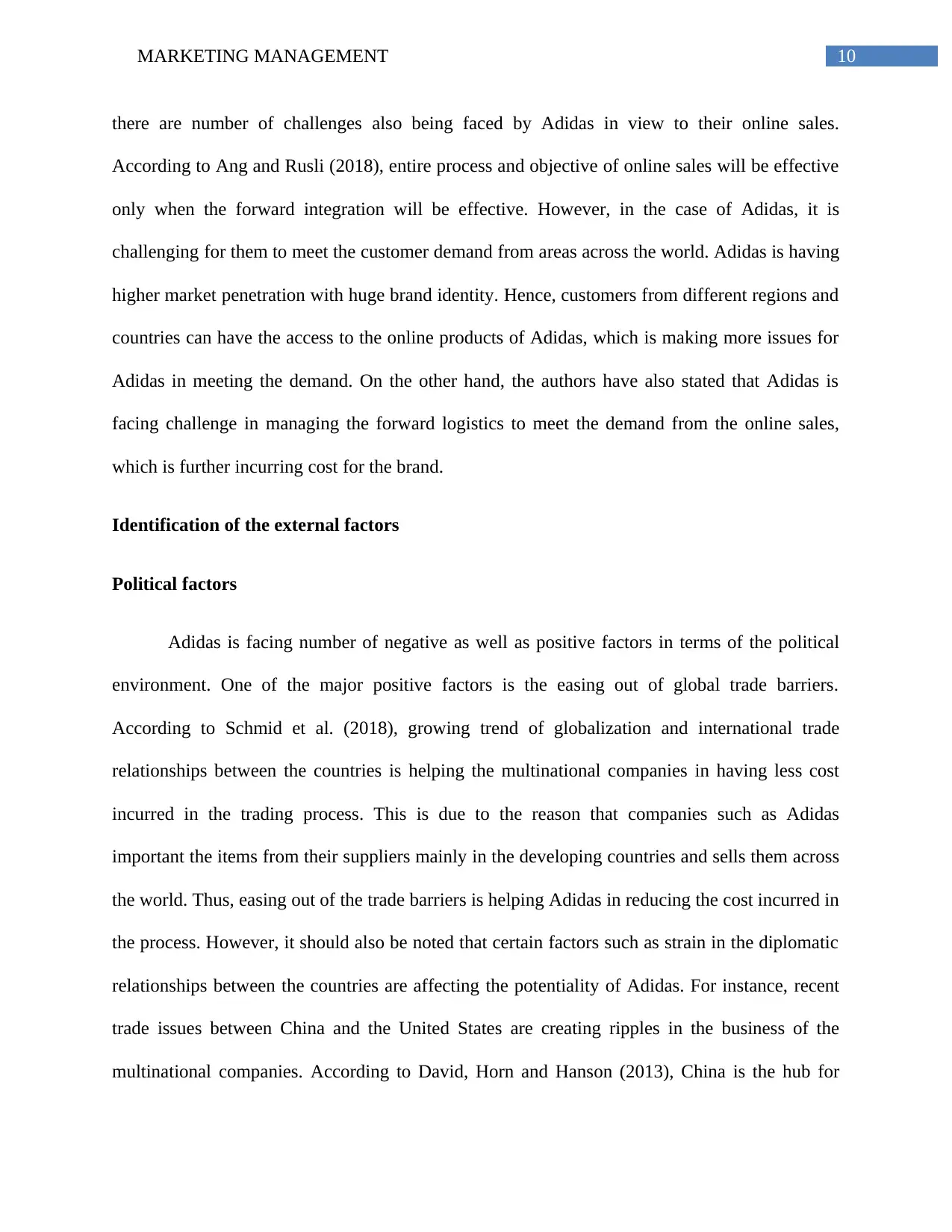
10MARKETING MANAGEMENT
there are number of challenges also being faced by Adidas in view to their online sales.
According to Ang and Rusli (2018), entire process and objective of online sales will be effective
only when the forward integration will be effective. However, in the case of Adidas, it is
challenging for them to meet the customer demand from areas across the world. Adidas is having
higher market penetration with huge brand identity. Hence, customers from different regions and
countries can have the access to the online products of Adidas, which is making more issues for
Adidas in meeting the demand. On the other hand, the authors have also stated that Adidas is
facing challenge in managing the forward logistics to meet the demand from the online sales,
which is further incurring cost for the brand.
Identification of the external factors
Political factors
Adidas is facing number of negative as well as positive factors in terms of the political
environment. One of the major positive factors is the easing out of global trade barriers.
According to Schmid et al. (2018), growing trend of globalization and international trade
relationships between the countries is helping the multinational companies in having less cost
incurred in the trading process. This is due to the reason that companies such as Adidas
important the items from their suppliers mainly in the developing countries and sells them across
the world. Thus, easing out of the trade barriers is helping Adidas in reducing the cost incurred in
the process. However, it should also be noted that certain factors such as strain in the diplomatic
relationships between the countries are affecting the potentiality of Adidas. For instance, recent
trade issues between China and the United States are creating ripples in the business of the
multinational companies. According to David, Horn and Hanson (2013), China is the hub for
there are number of challenges also being faced by Adidas in view to their online sales.
According to Ang and Rusli (2018), entire process and objective of online sales will be effective
only when the forward integration will be effective. However, in the case of Adidas, it is
challenging for them to meet the customer demand from areas across the world. Adidas is having
higher market penetration with huge brand identity. Hence, customers from different regions and
countries can have the access to the online products of Adidas, which is making more issues for
Adidas in meeting the demand. On the other hand, the authors have also stated that Adidas is
facing challenge in managing the forward logistics to meet the demand from the online sales,
which is further incurring cost for the brand.
Identification of the external factors
Political factors
Adidas is facing number of negative as well as positive factors in terms of the political
environment. One of the major positive factors is the easing out of global trade barriers.
According to Schmid et al. (2018), growing trend of globalization and international trade
relationships between the countries is helping the multinational companies in having less cost
incurred in the trading process. This is due to the reason that companies such as Adidas
important the items from their suppliers mainly in the developing countries and sells them across
the world. Thus, easing out of the trade barriers is helping Adidas in reducing the cost incurred in
the process. However, it should also be noted that certain factors such as strain in the diplomatic
relationships between the countries are affecting the potentiality of Adidas. For instance, recent
trade issues between China and the United States are creating ripples in the business of the
multinational companies. According to David, Horn and Hanson (2013), China is the hub for

11MARKETING MANAGEMENT
global manufacturing processes including Adidas and the United States are their largest market.
Thus, trade war between China and the United States is causing issues for them.
Brexit is another negative factor for Adidas due to the reason that it will affect the free
trade region in the European Union. United Kingdom is one of the largest and potential markets
for Adidas and brexit will cost the advantages that are being gained by Adidas in having the free
trade areas among the countries in the European Union. Colantone and Stanig (2018) stated that
due to brexit, Adidas will face the issue of tariffs and taxes in operating in the United Kingdom.
On the other hand, the growing popularity of the trading blocs will have positive impact on the
international business of Adidas due to the fact that they are beneficial in creating the free trade
regions among the member countries of the bloc.
Figure: 2
Trend of trade among NAFTA countries
Source: (fb.org 2019)
global manufacturing processes including Adidas and the United States are their largest market.
Thus, trade war between China and the United States is causing issues for them.
Brexit is another negative factor for Adidas due to the reason that it will affect the free
trade region in the European Union. United Kingdom is one of the largest and potential markets
for Adidas and brexit will cost the advantages that are being gained by Adidas in having the free
trade areas among the countries in the European Union. Colantone and Stanig (2018) stated that
due to brexit, Adidas will face the issue of tariffs and taxes in operating in the United Kingdom.
On the other hand, the growing popularity of the trading blocs will have positive impact on the
international business of Adidas due to the fact that they are beneficial in creating the free trade
regions among the member countries of the bloc.
Figure: 2
Trend of trade among NAFTA countries
Source: (fb.org 2019)
⊘ This is a preview!⊘
Do you want full access?
Subscribe today to unlock all pages.

Trusted by 1+ million students worldwide
1 out of 20
Related Documents
Your All-in-One AI-Powered Toolkit for Academic Success.
+13062052269
info@desklib.com
Available 24*7 on WhatsApp / Email
![[object Object]](/_next/static/media/star-bottom.7253800d.svg)
Unlock your academic potential
Copyright © 2020–2025 A2Z Services. All Rights Reserved. Developed and managed by ZUCOL.





